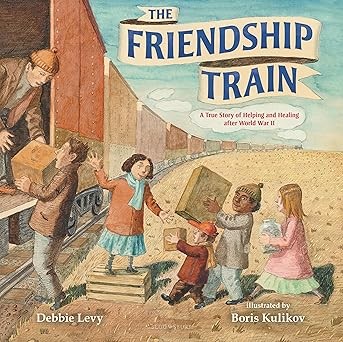
This is one of a trio of books by Yomata. Each is titled with an important question to be considered before even opening the book. What Do You With An Idea? What Do You Do With A Chance? What Do You Do With A Problem? To introduce this trio I would use the titles to make an interactive bulletin board. I would emphasize the you in each question by enlarging it and having students put a photo of themselves by the question they want to answer. Then I’d have them create responses using writing, photos, illustrations, recipes—using their creativity to demonstrate how they would answer the question. And we haven’t even opened the books yet. When it is time to open the books, I’d have students divide into teams to explore the book titled with the question they responded to. These books were written to nurture creativity and imagination. What Do You Do With An Idea helps move beyond resistance to new ideas, our own or those of others. What Do You Do With A Problem encourages readers to face and embrace their fears when confronted with a challenge. What Do You Do With A Chance gives guidance in what to do when presented with an opportunity.
What Do You Do With An Idea? This is a story, written in first person from the perspective of a child, that explores an idea from its origination, to ignoring it, to being pursued by it, to exploring it with others, to being discouraged from pursuing it, to refining the idea and finally bringing it to fruition. “I decided to protect it, to care for it. I fed it good food. I worked with it. I played with it. But most of all I gave it my attention.” The ending is amazing. What does the character do with his idea—and what do you do with an idea? “You change the world.” All quality books and ideas should lead to changing the world. This trio of books does just that.
The illustrations are created by Mae Besom using water color and pencil. Students should be reminded that this metaphorical story of an idea is incomplete without the added details and intentional color decisions created by the illustrator. Students may be interested in knowing that Kobi and Mae were not able to communicate through words while collaborating on these books. Kobi only speaks English and Mae only speaks Mandarin Chinese. But they learned that creativity has no language barrier.
As the fly-leaf of the book says—“It’s a story to inspire you to welcome that idea, to give it some space to grow, and to see what happens next. Because your idea isn’t going anywhere. In fact, it’s just getting started.” And don’t forget to go and get the companion books. Just an idea.
To make it more fun—there is a plush toy, the Idea. There is also an online read-aloud but I felt the introduction was much better than the actual read-aloud.
About the Author
Kobi Yomata is the president of Compendium, a company of amazing people doing amazing things. Students probably won’t be impressed by that. But he wants kids to know that behind every single thing they use there was first an idea. His purpose for writing this trio was to help kids get ideas out of their heads and into their hearts.
There is an interview with Kobi at thechildren’sbookreview.com. He reveals that he writes because, “Words have meaning and are only here a little while.” He reads because, “Where else can you experience a world that is created both by the author and the images of your own imagination?” Who is his greatest inspiration—“My wife, because she never ceases to believe in me.” And what a perfect answer to the question, “What do you do when you aren’t reading or writing?” Kobi’s response, “I am grateful. I’m ridiculously fortunate to live a life filled with love and laughter.”
Teaching Tags: Imagination, Creativity
Pathways Theme: Personal Feelings & Growth
Reviewed by Krystal Bishop, EdD
Professor of Education
Southern Adventist University


Author: Debbie Levy